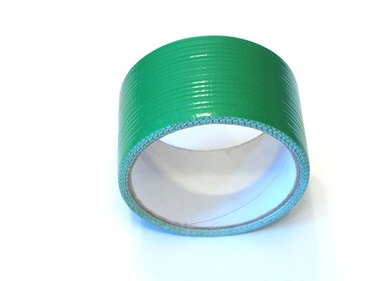Things You'll Need
Polyethylene plastic sheets
Roll of duct tape
Scissors

Polyethylene plastic sheeting has a variety of uses in home maintenance. Primarily, it protects walls, floors and furniture from paint or other liquids. It can also be used to seal doors and windows to prevent harmful gases or materials from entering a room. There are several ways to safely seal plastic sheets so nothing can seep through the seams, but duct tape is a simple, practical and inexpensive way to seal two or more plastic sheets for your home project.
Preparing the first sheet
Step 1
Lay your first sheet down flat on a clean, dry surface. Cut a small piece of tape and tack one end of the sheet down to your surface.
Video of the Day
Step 2
Spread the sheet to ensure it is down flat. Cut another piece of tape and tack it down to the other end of the sheet.
Step 3
Smooth out the sheet once more to ensure it is completely flat. Adjust a piece of tape if necessary.
Attaching the second sheet
Video of the Day
Step 1
Lay down another sheet with 1 inch overlapping the edge of the first piece. Spread the sheet flat and tack the two ends down -- the same way you did the first sheet.
Step 2
Cut a piece of tape 1 foot long. Place the edge of the piece at the end of the sheet. Make sure half of the tape is lined up over each sheet.
Step 3
Stretch it as far as it goes. Hold it slightly above the surface of the sheet with one hand.
Step 4
With your other hand, quickly swipe the piece of tape down onto the sheet. Smooth out any air bubbles that may appear.
Step 5
Cut another piece of tape and overlap the edge on the edge of the first piece. Repeat steps 3 through 5 until the two sheets are fully attached. Repeat sections 1 and 2 for as many sheets as necessary.
Covering objects
Step 1
Repeat steps 2 and 3 from section 2 and tape the sheets to the wall, floor, window, door or whatever needs to be covered.
Step 2
If necessary, add a second strip of tape over the original piece to strengthen the bond.
Step 3
Seal all corners and edges as necessary. Add diagonal pieces of tape over each corner.
Tip
Always use scissors to cut pieces of duct tape. Using your hands and/or teeth can produce uneven and/or broken pieces with holes in them.
Use plastic sheeting that has a thickness of at least 10 mm.
Your work surface should be hard, clean, dry, flat and even. A clean workbench is ideal, but you can tape the sheeting together on the floor if it is clean. Carpeting is not recommended for a work surface.
Some surfaces are not great adhesives for any type of tape, let alone duct tape. If this problem arises, use a hammer and nail to hang the sheets. Cover the nail with a piece of tape.
When applying the tape, it's best to work in the direction of your strong hand to ensure the tape is attached smoothly and evenly. For example, if you are right-handed, apply the tape to the right.
Warning
Don't overdo the taping. The room should be sealed, but not to the point where air can't get in or out and cause asphyxiation.
Using duct tape on painted surfaces is not recommended. Removal of the tape could rip the paint off the surface.